Jeff Koons, Whose Early Work Mined Childhood Objects to Unsettling Effect, Has a New Game — Literally
Considered by many to be the heir of Andy Warhol, he is an interesting look at what Warhol may have become: not so much an artist but an international brand.

Jeff Koons, who is easily one of the most recognizable contemporary artists in the world at present, has been keeping a relatively low profile. As one of the art world’s mega stars, he has made his mark with his intense inquiry into the eternal qualities of everyday things, marrying it with a gosh golly gee whiz hucksterism that many have called its own art performance.
Considered by many to be the heir of Andy Warhol, he is an interesting look at what Warhol may have become: not so much an artist but an international brand.
Mr. Koons was present at a Success Academy charter school at Hell’s Kitchen on Thursday morning to promote a new literacy game he has developed in conjunction with the education company “Clever Noodle.” Titled “Popped,” it features his shiny signature balloon dog on the box. The press were invited to the presentation at the school, less an art opening than a soft product launch.
That Mr. Koons would make such an unexpected leap is no surprise. He has long operated as the Willy Wonka of art, an unpredictable eccentric who employs a secret factory of at least two hundred artisans, technicians, and painting assistants. The manufacture of new work, commissioned and public, is continuous.
One recent project places colored lawn ornaments, known as “gazing balls,” in front of painstaking replicas of iconic classical works by Goya, Titian, and El Greco. His moon sculptures, called “Moon Phases,” will soon be deposited on the lunar surface by lander if all goes according to plan. It’s another outlandish project in a career arc defined by them.
Yet Mr. Koons has also remained remarkably consistent in his approach. His early work, much like Mike Kelly and his stuffed animals, mined the ephemeral objects of childhood for their evocative and unsettling qualities.

His early work “I told you once, I told you twice” features a pink inflated elephant, a panda, and a montage of glazed porcelain figurines. Taking cutesy kitschy things witnessed at grandma’s house, he re-represents or reconfigures them in ways that makes us uneasy.
Mr. Koons’s fondness for inflatable figures and collectible porcelain has remained, but he also has a love for pristine, factory-made things. Mr. Koons first successful show was a presentation of 20 new vacuum cleaners in clear acrylic cases, all dramatically underlit with fluorescent lighting. It got him noticed.
Having acquired a commodities trading license to fund the project, he titled it “The New.” Mr. Koons had arrived at New York’s Lower East Side as a mustachioed, work shirt and jean clad wearing artist, one you might find hanging out at the artist run restaurant FOOD. His vacuum show gave him a new persona: Madison Avenue salesman in checked jacket and slacks.
It was around this time that he developed his highly peculiar form of artistic newspeak, a blend of corporate jargon, pop psychology, and art theory. Mr. Koons speaks about achievement, fulfilling potential, and reaching his goals. He also speaks about his feelings and the spiritual qualities of objects.
The schtick was just odd and off putting enough to win him admirers. His attribution of frankly sexual qualities to mechanical objects, as he did with his vacuum cleaners, gave his pitch a creepy, Ballardian edge. Mr. Koons was at once hyper conventional and weirdly off, reinventing himself as both artist and consummate pitchman. You’re never quite sure which one is talking.
These are the tensions that catapulted Mr. Koons to international superstardom. The schtick intensified. With his “Made in Heaven Series,” a collaboration between himself and Italian porn starlet Ilona Staller, who he had married, they reached a fever pitch. Presented at the Whitney in 1989 under a strict age advisory, Mr. Koons created a series of pornographic billboards that had him and Ms. Staller explicitly recreating the Kama Sutra.
They are photographed entwined in something resembling the classical Paphian bower of connubial bliss, but filtered through the pastel imagination of Cecil B. DeMille. It was compelling, deeply weird, a little grotesque, and it scandalized more than a few. Mr. Koons was present in his signature suit, whipping up the press with his madcap hand gestures and fathomless, goofy grin.
The next huge success was far less outrageous and is emblematic of his work as a whole. Mr. Koons took an inflatable balloon dog, that staple of a child’s birthday parties, and recreated it as an enormous, stainless-steel sculpture. It is the perfect emblem of his aesthetic. He has taken something cherished, disposable and ephemeral and made it permanent, indestructible even.
As such it has brightness and life, almost as if in fulfillment of a child’s deepest wish. Like all things Mr. Koons, it looks utterly simple, but costs eye-watering amounts of money and technical inventiveness to actually make.
Now it graces the box of his new literacy game for children, ensuring that his work has gone to pop culture branding symbol from critique of pop culture. I went to witness Mr. Koons’s launch of the game in the halls of Success Academy Thursday morning.
When I arrived, elementary students were happily playing the game, and he was supervising students in a jacket, slacks and sneakers, sporting his perennial grin.
Mr. Koons’s press team closed in and whipped me into shape immediately. “Mr. Koons will be presenting to the children after the play session” I was told.
Then “Mr. Koons will be available in the hallway for ten minutes before his interview with CNN.” Also “We will send you an email with approved quotes and sound bites from Mr. Koons.”
The children were then called to order and they presented Mr. Koons with a balloon dog card, by way of thanks. Visibly touched, he told them how special they were, and how deeply proud he was of their accomplishments.
Outside in the hallway, I managed to stand next to him and ask one question. In person Mr. Koons is thoughtful and slightly stooped, less Willy Wonka and more Mr. Rogers. “In the beginning you focused on the production of some very iconic artworks that probed the qualities of everyday things.” I asked. “Now you appear to be more involved in projects like these. What has shifted?”
He pursed his lips and answered carefully:
“I used to put a great deal of attention into making my objects. But I began to slowly realize that these objects were metaphors for people. And I realized that the reason I created these objects was to show people that I cared for them.”
He added that “I do believe that the purpose of life is to create special relationships with people and let them know that you care for them. So I now try to do this more directly, with these projects and with this game. I think it’s really wonderful and very important.”
It should be said that he sounds deeply sincere, and there is no reason to disbelieve him. It is impossible, however, to say that I know anything more about Mr. Koons after meeting him in person. He exists in a strange uncanny valley of his own making. Perhaps by gazing into the sacred heart of commodities over so many decades, he has become one himself.

